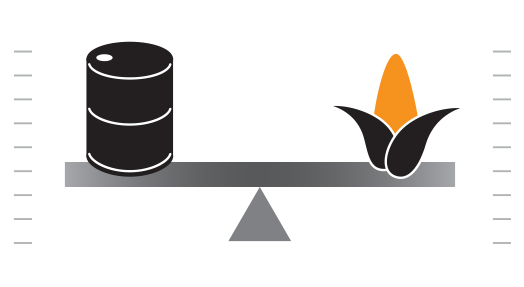Pros and Cons of Biofuel
Shanghai announces that it may be using processed ‘gutter oil’(地溝油)to fuel its vehicles within two years’ time. If this proves feasible, the notorious fluid, essentially waste oil recycled from restaurants, sewer drains, and abattoir waste, may stop insidiously appearing on restaurant tables. Not only that—if large-scale production is possible, it may even become China’s newest biofuel.
‘Biofuel’ is a buzzword these days as governments and scientists seek ways of making transportation sustainable. But what is biofuel? Biofuel is any type of energy derived from a plant source. The most common are ethanol, an alcohol fuel made from fermenting a sugary crop like sugar cane or corn, and biodiesel, a diesel fuel made from vegetable fats and oils.

Biofuel vs Fossil Fuel
The benefit of a plant-based fuel is that it comes from a renewable resource, unlike fossil fuels such as coal, gasoline and natural gas, which are formed from decomposed organisms buried in the ground for millions of years. The production of fossil fuel also involves many high-consumption processes that biofuel does not—digging of oil wells, pumping the oil, refining it, transporting it over land and sea.

Biofuel is much cleaner too, as it releases less carbon dioxide and benzene into the air than fossil alternatives. Corn and some other plants used as feedstock also absorb atmospheric carbon dioxide in their growth stage, greatly reducing CO2 levels over the entire fuel life cycle. Another advantage of biofuels is that they have less mass than fossil fuels, which when applied to air travel could mean cheaper tickets and a smaller carbon footprint.
Economically, homegrown biofuels have the potential to give farmers in developing countries better income. Millions of farmers who couldn’t afford the market prices of their food crops could grow biofuel feedstock and receive a higher price for a much coveted commodity.
Costs of Conventional Biofuel
Biofuels can be green or not so green, depending on how it’s made and where it comes from. In fact, the worst kind of biofuel, such as palm oil and sugarcane whose cultvation has led to deforestation and less land for food crops, is not necessarily better than the most environmentally benign fossil fuel.
Like bananas and rice, certain biofuel crops grow better in certain regions than others. This means that some regions would have to cultivate them at a higher price, or import the fuel, raising both cost and the amount of emission produced. Likewise, the water demands of ‘thirsty’ crops such as corn can put pressure on local water resources.
Increase in demand for food-biofuel crops such as corn and soybean also lead to price spikes which benefit the farmers at the expense of other farmers who use the crop to feed their livestock. This eventually translates into more expensive meat at the grocery store, and less food for the poor. Reports from the World Bank and the UN have pointed to the growing demand for biofuel as a key factor contributing to the rapid rise in food prices.
Deforestation
The demand for biofuel and, sadly, the monetary reward this entails, often motivate plantations to expand quickly. In Indonesia, expansion by palm oil plantations has caused serious deforestation, and un-green production practices like draining and burning peat bogs to prepare farmland have made the country a leading greenhouse gas emitter. Therefore it is important that such crops are grown and harvested in the same spirit that inspired the use of plant-based fuels in the first place.
Greener Biofuel Options
Alternative energy scientists are looking for ways to overcome these drawbacks, such as by developing more weather-resistant crops. Researchers have also identified a new generation of non-food-source ethanol feedstock that seems to steer clear of the problems afflicting their predecessors. These include tall grasses that can grow in poor soils with little irrigation or fertilizer input, algae that thrives in salt water, fresh water, even in wastewater, and garbage from landfills that can be converted into fuel. This bodes well for ‘gutter oil’ which may find a new and respectable career in the not-so-distant future.

Biofuels in Hong Kong
Most cars can run on fuel with a certain percentage of bioethanol or biodiesel with no performance issues. Car manufacturers should be able to advise car owners on the optimum ratio. However bioethanol and biodiesel are not available from gas stations in Hong Kong yet. There are a few plants that manufacture biodiesel from waste cooking oil in Hong Kong. Ironically, a major challenge faced by the industry is competition with mainland buyers for used cooking oil. The latter resell this toxic ‘gutter oil’ as it is commonly called, to restaurants across the border as cooking oil. Hopefully, with more government support and conscientious recycling of waste cooking oil, biodiesel production will soon become more economical. Zero Carbon Building is a green building in Kowloon Bay that uses locally produced B100 biodiesel made from waste cooking oil, which supplies 70% of electricity to the building.



